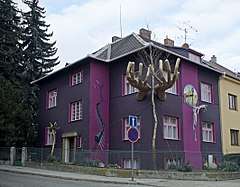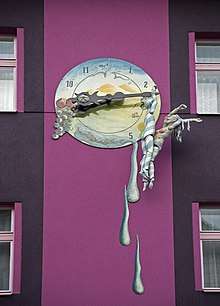Kristek House
| Kristek House | |
|---|---|
| Kristkův dům | |
 | |
| General information | |
| Address | Tišnovská 77, 613 00 Brno |
| Town or city | Brno |
| Country | Czech Republic |
| Coordinates | 49°12′37″N 16°37′31″E / 49.21028°N 16.62528°ECoordinates: 49°12′37″N 16°37′31″E / 49.21028°N 16.62528°E |
Kristek House (Czech: Kristkův dům) is a building on the corner of Tišnovská and Trávníky Streets in Brno, Czech Republic that was transformed into a monumental assemblage by the Czech sculptor, painter and action artist Lubo Kristek. The house-assemblage is dedicated to the myth of Sisyphus.
Origin
The surrealist Lubo Kristek[1] was born in Brno and lived on Tišnovská Street during his childhood.[2] In 1968, he emigrated to West Germany and made study trips to many other countries.[3] In 2015, after his lifelong journey, he returned to "his" street. Kristek's return led him to conceive the idea of filming the story of Sisyphus. In 2015–2017, he consequently transformed his own house into a monumental assemblage showing the cycle Sisyphiade or Boulder in Time[4] and into a film set to be able to show various perspectives of this assemblage.[1]
Description

Kristek was inspired by Albert Camus and his Myth of Sisyphus, but even more by the ideas of George Voskovec recorded on the LP Relativně vzato.[5] Kristek met Voskovec in the 1970s during his exhibition tour in the USA.[6]
Voskovec concentrates on the thoughts going through Sisyphus's mind during his descent from the top of the hill to its foot to find the boulder again. He is absolutely free in these moments, he has no "boulder". Lubo Kristek developed this concept and added the flow of time. Sisyphus circulates on the clock attached to the minute hand.
Sisyphus is trapped in time, when he circulates on the hand on the clock face. From six upward, he tries to hold time back. However, after he surmounts the climax of relativity, there comes a relief and fulfilment of his desires, although he is surrounded by a more and more absurd and ill world.
— Lubo Kristek[4]
The clockwork was designed and constructed especially for this purpose by the Elekon company (Vyškov), a specialist in public clocks.[7] The system provides exact time and incorporates a changeover to winter time.[2]
Another nook of Kristek House is dedicated to a train from Kristek's childhood, the former Brno-Tišnov railway line (in Czech: Tišnovka).[8] In his mind it never stopped existing, so he felt a need to visualise it with the help of art. The railway line is painted on the façade and incorporated into one of the artist's important symbols – the heavenly highway. This symbol can be found already in his painting The Heavenly Highway of Aunt Fränzi (1974) that is today part of the collection of Neues Stadtmuseum in Landsberg am Lech.[9] Two free birds that have just hatched (reminder of ab ovo – from the beginning, the egg) fly above the highway.
Two golden hands rise from the corner of the house and reach for the heavens. The hands also protect the living tree and together represent the central symbol of the monumental assemblage.[2]
— Boerries-Peter Kopton[10]
Context

In Kristek's assemblages from the 1960s, for example in Expecting (1969)[11], the existential nature is apparent as well as the concerns about survival of humanity.[10] His works from the 1970s, for example the assemblage Soundproof Aesthetic of Luxuriety (1976)[12], point out to the hidden traps in modern society.[13] In 1980s, Kristek created his assemblages in landscape from found material, often cast out by the sea,[14] as in Christ's Barbed Wire (1983)[15] and Sea Horse (1986)[16]. He incorporates waste to his later works, as in assemblage On the Landfill of Ages (1994)[17] and some of his assemblages, as Requiem for Mobile Telephones (2007)[18], originated in happening, in which he ritually destroyed the achievement of modern era – mobile telephone – as a protest against the addiction on modern technologies.[19] In the monumental assamblage Kristek House, he incorporates the motifs of house, home and privacy into the work of art and relates to nature. The artist treats the house as a living being that is constantly changing.[1]
Kristek House became the venue of the films Ab ovo and Sisyphiade.[1] It belongs to Lubo Kristek's considerable feats in public space together with his contribution to the sacral buildings with his wall altar Transcendental Composition between Suffering and Hope (1977) in the chapel in Penzing; with his metal sculpture Monument to the Five Senses (1991) standing in front of Neues Stadtmuseum in Landsberg am Lech[20], large-scale architectural sculpture Tree of Knowledge (1982) in Ignaz Kögler Gymnasium in Landsberg am Lech, bronze fountain Drinking (1988) in Theresienbad Greifenberg[21] and his sculpture pilgrims' way Kristek Thaya Glyptotheque (2005–2006).[22] He also became internationally well-known thanks to his tens of happenings that he organized in Germany, the USA, Canada, Italy, Spain, Czech Republic, Austria, Turkey, Poland or Slovakia.[23]
References
- 1 2 3 4 "Dům performera Kristka bude dějištěm filmu". Ceskatelevize.cz (in Czech). Česká televize. 6 December 2017. Retrieved 6 February 2018.
- 1 2 3 Kristkův dům (Television production) (in Czech). Btv. 2 February 2018. Retrieved 6 February 2018.
- ↑ Schwabe, Nick (1977). Lubo Kristek: Individual Visions of Sculptures from the Last 8 Years, 1968–1976 (PDF). Vancouver. p. 16. Retrieved 6 February 2018.
- 1 2 Homola, Miroslav (5 December 2017). "Kristkův Sisyfos si užívá na stěně domu každou hodinu ve čtvrt". Novinky.cz (in Czech). Borgis. Retrieved 6 February 2018.
- ↑ Voskovec, Jiří (1975). Relativně vzato (Vinyl, LP, Mono) (in Czech). USA: Kampa Disc Productions, Inc.
- ↑ "Surrealistický dům Luba Kristka v Brně". Kudyznudy.cz (in Czech). Czech Tourism. 2 February 2018. Retrieved 6 February 2018.
- ↑ Elekon Certificate
- ↑ "Umělec surrealisticky vyzdobil dům". Idnes.cz (in Czech). ČTK. 5 December 2017. Retrieved 6 February 2018.
- ↑ Půtová, Barbora (2018). "Chapter: Stations of the Glyptotheque – Introduction". Kristek Thaya Glyptotheque (1st ed.). Research Institute of Communication in Art. ISBN 9788090554832. Retrieved 7 February 2018.
- 1 2 Schwabe 1977, p. 1.
- ↑ Reproduced in Půtová 2018, Online
- ↑ Reproduced in Půtová 2018, Online
- ↑ Půtová 2018, Chapter: Meeting place – Introduction
- ↑ Půtová 2018, Chapter: Lubo Kristek: The Sun King in the Theatre of His Own World
- ↑ Reproduced in Půtová 2018, Online
- ↑ Reproduced in Půtová 2018, Online
- ↑ Reproduced in Půtová 2018, Online
- ↑ Reproduced in Půtová 2018, Online
- ↑ Půtová 2018, Chapter: Meeting place – Requiem for Mobile Telephones
- ↑ Schätze aus den städtischen sammlungen des Neuen Stadtmuseums Lansdberg am Lech (in German), Landsberg am Lech: Freundeskreis der Städtischen Museen Landsberg am Lech, 2005, p. 80–81. Free to download.
- ↑ Neunzert, Hartfrid (2008). Lubo Kristek: Third Eye of Distance Communication. Landsberg am Lech: Neues Stadtmuseum. OCLC 888617842.
- ↑ Půtová 2018. Kristek Thaya Glyptotheque
- ↑ Lubo Kristek Channel